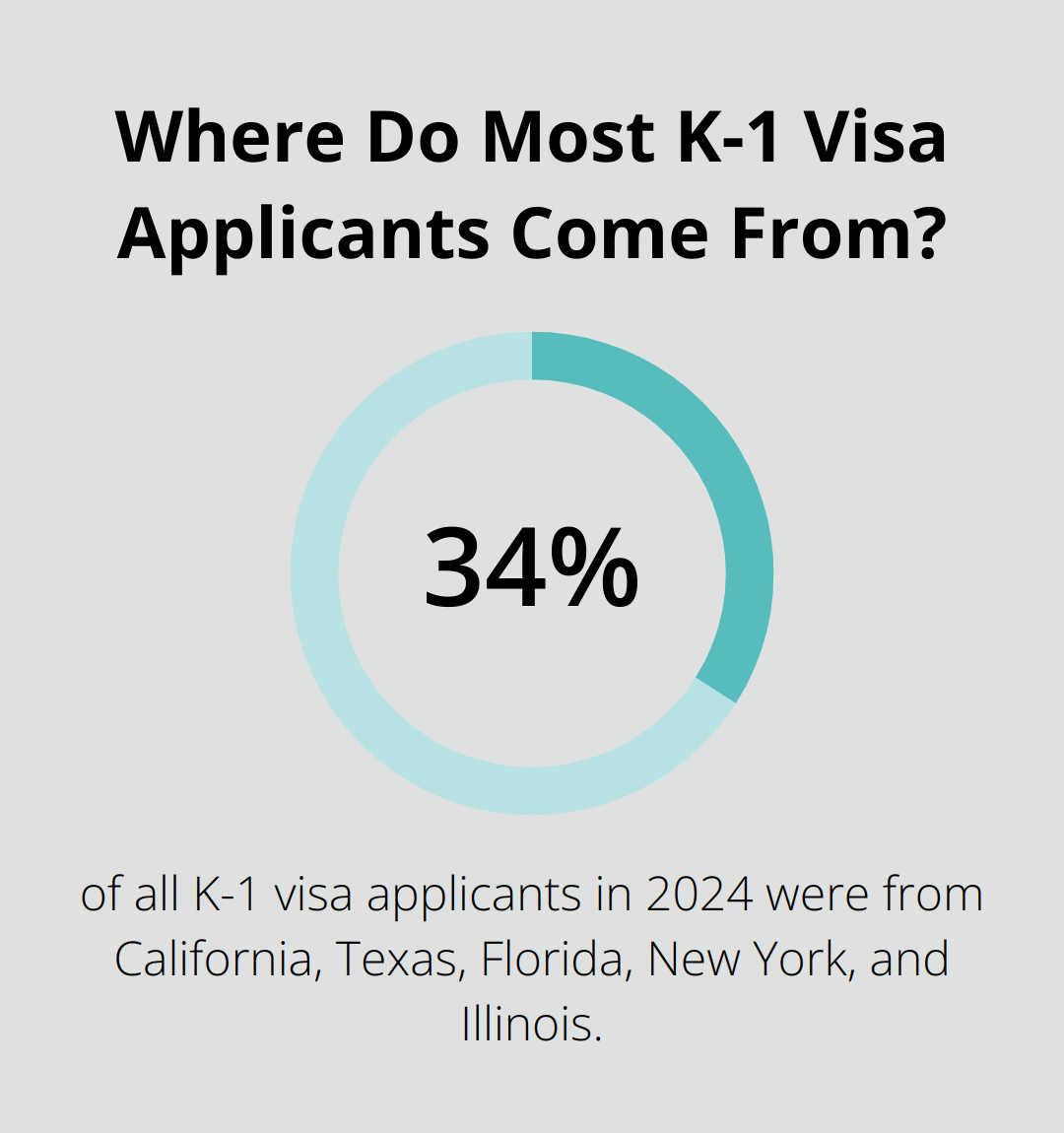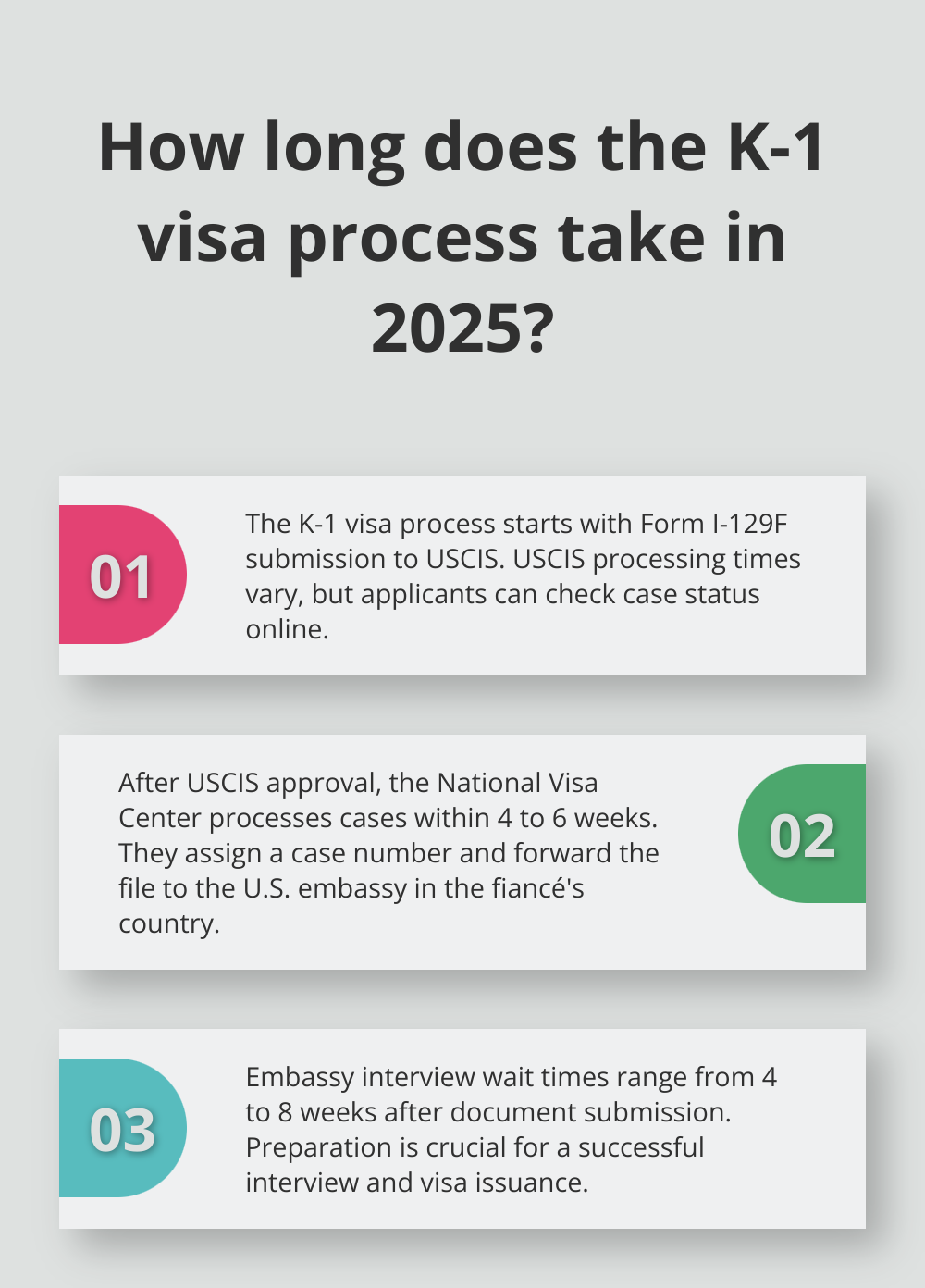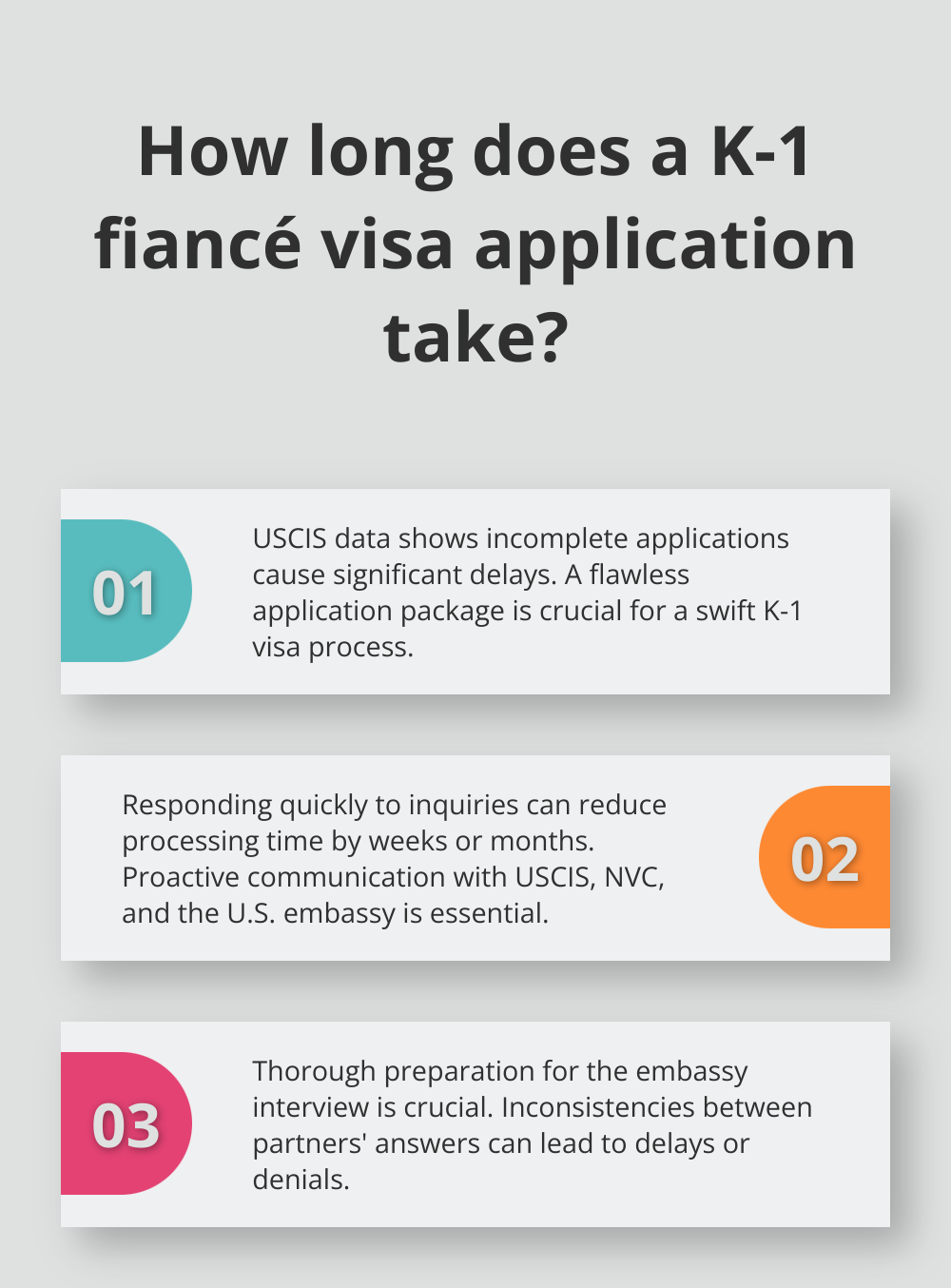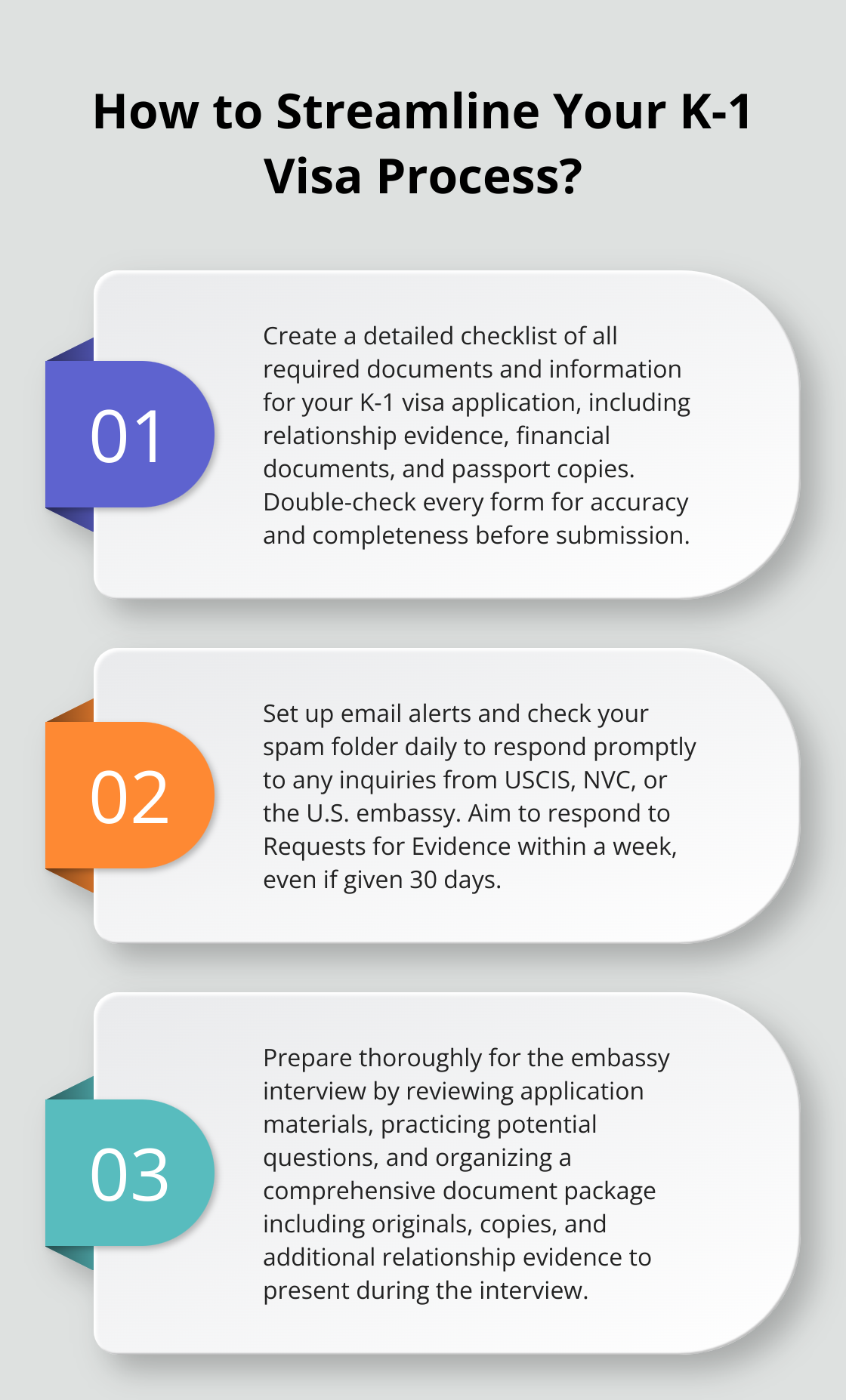
Fiancé Visa Processing Time in 2025: Latest Updates
Navigating the fiancé visa process can be complex, especially with changing timelines. In 2025, understanding the current fiancé visa processing time is crucial for couples planning their future together.
At Law Offices of Jeffrey A. Thompson, we’ve seen significant shifts in K-1 visa processing over the years. This post will explore the latest updates, provide practical tips, and help you navigate the application process more effectively.
How Long Does K-1 Visa Processing Take in 2025?
Current Processing Times
In 2025, K-1 fiancé visa processing has undergone significant changes. The average processing time now ranges from 10 to 16 months, a slight increase from previous years. The U.S. Citizenship and Immigration Services (USCIS) has adjusted the overall wait time to approximately 6.1 months in early 2025, down from 8.5 months in 2024.
Factors Influencing Processing Times
Several elements affect individual processing times:
- Application completeness and accuracy
- USCIS office workload
- Case complexity
- Geographic location
Errors or missing information can lead to Requests for Evidence (RFEs), potentially adding months to your wait time. Processing times also vary based on location, with less populated areas often processing applications faster than major cities.
Geographic Variations
Processing times can differ significantly depending on your location. For example, California, Texas, Florida, New York, and Illinois (accounting for 34% of all K-1 visa applicants in 2024) may experience longer wait times due to higher application volumes.
Improvements in Processing
USCIS has made substantial progress in reducing backlogs and streamlining processes. These improvements include:
- Digital filing implementation
- Automation of certain processes
- Increased efficiency in application review
As a result, USCIS approved 56,382 I-129F petitions in 2024, marking the highest approval rate in 12 years.
The Next Steps
While these processing times represent a significant improvement, it’s important to note that I-129F petition approval doesn’t guarantee visa issuance. The case undergoes further review at the U.S. consulate, which can extend the overall timeline. Understanding this process is key to preparing for the next steps in your K-1 visa journey, which we’ll explore in the following section on the fiancé visa application process.

How the K-1 Visa Process Works in 2025
Filing Form I-129F
The K-1 fiancé visa process starts with Form I-129F, Petition for Alien Fiancé(e). U.S. citizens submit this form to USCIS to establish their relationship with a foreign fiancé. In 2025, USCIS processes this form, and applicants can check case processing times, case status online, change of address, submit e-requests, and get password resets and technical support through the USCIS website.

To prevent delays, applicants must include all required documentation with their petition. This encompasses proof of U.S. citizenship, evidence of meeting in person within the last two years, and intent to marry within 90 days of the fiancé’s U.S. arrival. Incomplete applications often cause significant processing delays (sometimes adding months to the timeline).
National Visa Center Processing
After USCIS approves the I-129F, they forward the case to the National Visa Center (NVC). The NVC typically processes cases within 4 to 6 weeks. During this period, they assign a case number and send the file to the U.S. embassy or consulate in the fiancé’s home country.
A frequent delay at this stage occurs when applicants fail to respond quickly to NVC communications. Applicants should check their email regularly (including spam folders) to avoid missing important correspondence.
Embassy Interview and Visa Issuance
The final stage involves an interview at the U.S. embassy or consulate. Wait times for interview appointments vary by location but generally range from 4 to 8 weeks after document submission.
Preparation plays a key role in a successful interview. The foreign fiancé should be ready to answer questions about the relationship, future plans, and their background. Inconsistencies or lack of knowledge about each other can raise red flags and potentially lead to visa denials.
After a successful interview, if a K-1 visa is issued, the Consular Officer will give the applicant their passport containing the K-1 visa and a sealed packet containing the civil documents.
Potential Delays and How to Avoid Them
Several factors can cause delays in the K-1 visa process:
- Incomplete or inaccurate applications
- Failure to respond promptly to requests for additional information
- Insufficient evidence of a genuine relationship
- Background check issues
To minimize these delays, applicants should:
- Double-check all forms for accuracy and completeness
- Respond promptly to any requests from USCIS, NVC, or the embassy
- Provide comprehensive evidence of the relationship (e.g., photos, communication records, travel itineraries)
- Be prepared to address any potential issues in their background
Understanding these potential pitfalls can help applicants navigate the K-1 visa process more smoothly. The next section will explore specific strategies to expedite the application process and increase the chances of a successful outcome.
How to Speed Up Your Fiancé Visa Application
Perfect Your Application Package
A flawless application forms the foundation of a swift K-1 visa process. Fill out every form correctly and completely. Check all dates, names, and addresses twice. Include all required supporting documents, such as proof of your relationship, financial documents, and passport copies. Provide ample documentation of meeting in person within the last two years (a common pitfall).

USCIS data reveals that incomplete or inaccurate applications cause significant delays. Submit a comprehensive package upfront to avoid this setback.
Communicate Proactively
Respond quickly to any inquiries from USCIS, the National Visa Center (NVC), or the U.S. embassy. Set up email alerts and check your spam folder regularly. If you receive an RFE, try to respond within a week (even though you typically have 30 days). This proactive approach can reduce your total processing time by weeks or even months.
Prepare for Your Embassy Interview
Thorough preparation for the embassy interview is essential. Review your application materials and practice answering potential questions about your relationship and future plans. Inconsistencies between partners’ answers raise red flags that can lead to delays or denials.
Bring organized, easily accessible documentation to your interview (including original documents, copies, and any additional evidence of your relationship’s authenticity). Good preparation demonstrates your commitment and can result in a smoother, faster interview process.
Explore Premium Processing Options
Premium processing isn’t available for K-1 visas themselves, but you can use it for certain related applications. For instance, if you plan to adjust status after marriage, USCIS has waived any and all requirements for applicants for adjustment of status to that of a lawful permanent resident as of January 22, 2025. However, this option comes with additional fees and may not suit everyone.
In cases of extreme emergencies (such as life-threatening situations or severe financial loss), you can request expedited processing. USCIS grants these requests sparingly and requires substantial documentation to prove urgency.
Seek Professional Assistance
Consider enlisting the help of an experienced immigration attorney. A knowledgeable lawyer can guide you through the complex visa process, help you avoid common pitfalls, and ensure your application is as strong as possible. While it’s possible to navigate the process on your own, professional assistance can significantly reduce the risk of delays or denials.
Final Thoughts
The fiancé visa processing time in 2025 ranges from 10 to 16 months, reflecting a complex interplay of factors. Applicants must submit flawless application packages, respond promptly to requests, and prepare thoroughly for each step to minimize delays. USCIS improvements in efficiency have led to higher approval rates and reduced backlogs, but the journey still demands careful planning and execution.

We at Law Offices of Jeffrey A. Thompson understand the intricacies of the K-1 visa process and the importance of reuniting couples. Our experienced team provides expert guidance through every stage of your fiancé visa application, from ensuring your initial petition is complete to preparing you for the embassy interview. Our knowledge of immigration law, combined with our commitment to client success, can help streamline your journey and alleviate stress associated with the visa process.
The wait may seem long, but proper preparation and patience are key to a successful outcome. With the right approach (and professional assistance), you can navigate the fiancé visa process effectively, bringing you one step closer to starting your life together in the United States. Our comprehensive support, tailored to your specific situation, can make a significant difference in your K-1 visa journey.


